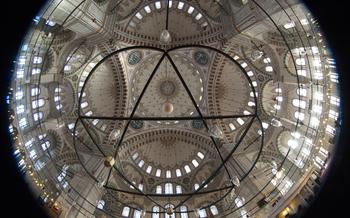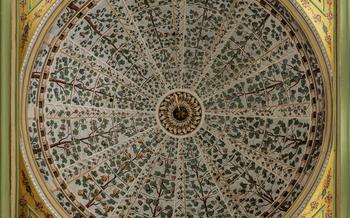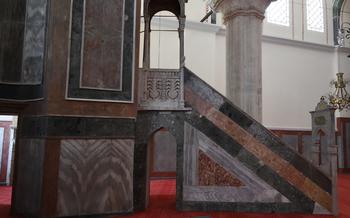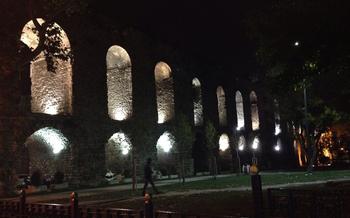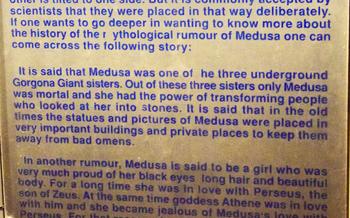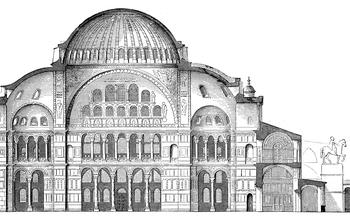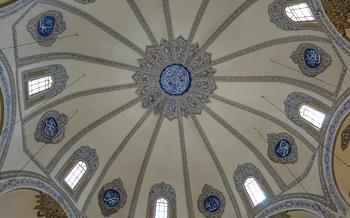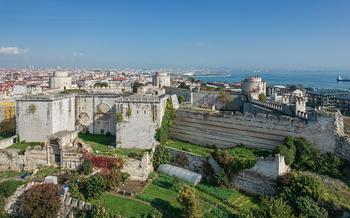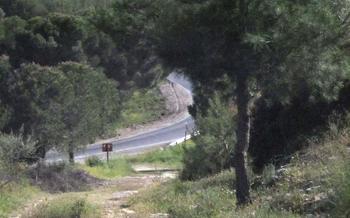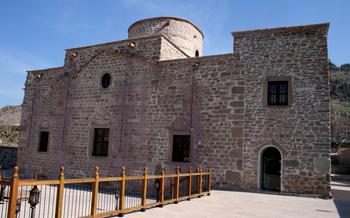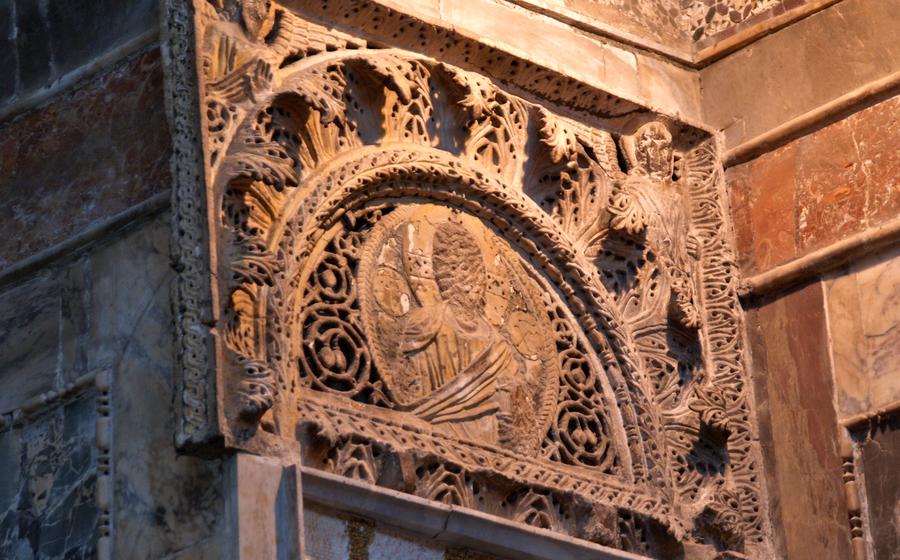
Chora Church (Kariye Museum)
- The Chora Church: A Byzantine Masterpiece
- Location and Transportation
- Visiting Hours and Fees
- Exploring the Interior
- The Narthex and Its Mosaics
- The Nave and Its Mosaics
- The Parecclesion and Its Mosaics
- The Apse and Its Mosaics
- The History of the Chora Church
- The Chora Church in Popular Culture
- Photography and Videography
- Accessibility for Visitors
- Nearby Attractions and Landmarks
- Insider Tip: Hidden Gem
The Chora Church: A Byzantine Masterpiece
The Chora Church, also known as the Kariye Museum, stands as a testament to the grandeur and artistry of the Byzantine Empire. With its stunning mosaics and frescoes, intricate architectural features, and historical significance, the church offers visitors a glimpse into the splendor of Constantinople, the former capital of the Byzantine Empire.
Dating back to the 4th century, the Chora Church underwent several renovations and additions over the centuries, culminating in the magnificent structure we see today. The church's architectural features showcase the fusion of early Christian and Byzantine styles, with its central dome, barrel-vaulted narthex, and intricate stone carvings.
The Chora Church is renowned for its exquisite mosaics and frescoes, which cover every inch of the interior. These intricate artworks depict biblical scenes, historical events, and portraits of saints, emperors, and empresses. The mosaics are remarkable for their vibrant colors, expressive figures, and intricate details, providing a glimpse into the artistic mastery of the Byzantine period.
The restoration and preservation efforts undertaken in the 20th century have played a crucial role in safeguarding this priceless heritage. The mosaics were carefully cleaned and restored, revealing their original brilliance and allowing visitors to appreciate their beauty and symbolism. The Chora Church stands as a testament to the dedication and expertise of those who have worked tirelessly to preserve this Byzantine masterpiece for future generations.
Location and Transportation
The Chora Church, also known as the Kariye Museum, is conveniently located in the Fatih district of Istanbul, Turkey. Its exact address is Kariye Müzesi, Kariye Cd. No:24, 34080 Fatih/İstanbul.
Reaching the museum is easy using public transportation. The closest tram stop is the Edirnekapı station, served by the T1 tram line. From there, it is a short 5-minute walk to the museum. Alternatively, you can take the Marmaray train to the Halkalı or Ayrılıkçeşme stations and then transfer to the T1 tram line.
The Chora Church is also within walking distance of several other attractions in Istanbul. The Süleymaniye Mosque, one of the city's most iconic landmarks, is just a 15-minute walk away. The Grand Bazaar, a bustling marketplace with over 4,000 shops, is also within easy reach, about a 20-minute walk from the museum.
Visiting Hours and Fees
Visiting the Chora Church, now known as the Kariye Museum, involves specific hours and fees to ensure its preservation and accessibility. Here's a breakdown of the visiting information:
- Admission Fees:
- Adults: 60 Turkish Lira (TL) (approximately 10 USD)
- Students: 30 TL (approximately 5 USD)
- Children under 12: Free admission
-
Discounts may be available for groups and educational visits.
-
Opening and Closing Times:
- Summer (April 15 - October 31): 9 am to 7 pm daily
- Winter (November 1 - April 14): 9 am to 5 pm daily
-
The museum is closed on Mondays.
-
Guided Tours Availability:
- Guided tours are available in various languages, including English, Turkish, and other languages upon request.
- Tours typically last for about an hour and provide in-depth information about the church's history, mosaics, and architecture.
- Visitors can inquire about guided tours at the museum's ticket counter or book them in advance through tour operators.
Exploring the Interior
Stepping inside the Chora Church is like stepping into a time capsule of Byzantine art and history. The walls and ceilings are adorned with stunning mosaics and frescoes, each one a masterpiece of religious art. The mosaics depict scenes from the Bible, the life of Jesus Christ, and the history of the church itself. The level of detail and craftsmanship is simply breathtaking.
The mosaics in the nave, or main body of the church, are particularly impressive. They depict scenes from the Old Testament, including the creation of the world, the expulsion of Adam and Eve from Paradise, and the story of Noah's Ark. The Virgin Mary and the life of Christ are also depicted in great detail, with scenes such as the Annunciation, the Nativity, and the Crucifixion.
The mosaics in the pareccleision, or side chapel, are also worth seeing. They depict scenes from the life of the Virgin Mary, including her birth, her marriage to Joseph, and her death. The mosaics in the apse, or sanctuary, are the most famous and impressive of all. They depict a majestic image of Christ Pantocrator, surrounded by angels and saints. The symbolism of the apse mosaics is rich and complex, and they offer a glimpse into the theological beliefs of the Byzantine Empire.
The Narthex and Its Mosaics
The narthex, or entrance hall, of the Chora Church is adorned with a series of captivating mosaics that set the tone for the artistic wonders to come. These mosaics depict scenes from the life of Jesus Christ, beginning with the Annunciation to Mary and continuing with his birth, baptism, and triumphant entry into Jerusalem. The vivid colors and intricate details of these mosaics bring the stories to life, immersing visitors in the narrative of Jesus' earthly ministry.
Among the highlights of the narthex mosaics are the portraits of Byzantine emperors, who are depicted in a state of prayer or adoration. These portraits provide a glimpse into the political and religious landscape of the Byzantine Empire and underscore the close relationship between the church and the imperial court. The narthex mosaics also feature a wealth of symbolism and iconography, with each element carefully chosen to convey a specific message or meaning. For example, the use of peacocks in the decoration symbolizes immortality and resurrection, while the depiction of lions represents strength and majesty.
The Nave and Its Mosaics
The nave, the central section of the Chora Church, boasts an awe-inspiring collection of mosaics that narrate scenes from the Old Testament, the life of the Virgin Mary, and the life of Christ. These mosaics are arranged in tiers, with each tier depicting a different episode or event.
Among the highlights of the nave mosaics are the scenes depicting the Creation of the World, the Fall of Adam and Eve, the Sacrifice of Isaac, and the Crossing of the Red Sea. These mosaics are remarkable for their intricate details, vivid colors, and expressive figures.
The depiction of the Virgin Mary and the life of Christ occupies a prominent position in the nave mosaics. The Annunciation, the Nativity, the Baptism of Christ, the Transfiguration, and the Crucifixion are just a few of the many scenes portrayed. These mosaics showcase the deep devotion and reverence that the Byzantine Christians had for the Virgin Mary and her son, Jesus Christ.
The architectural features of the nave also contribute to its grandeur. The soaring arches, the ribbed vaults, and the massive columns create a sense of spaciousness and luminosity. The interplay of light and shadow on the mosaics further enhances their beauty and drama.
The Parecclesion and Its Mosaics
The parecclesion, a smaller chapel within the Chora Church, boasts its own collection of captivating mosaics. These mosaics, while smaller in scale compared to those in the nave and apse, offer an intimate and equally stunning glimpse into Byzantine art.
One of the highlights of the parecclesion mosaics is the depiction of the life of the Virgin Mary. These mosaics narrate various scenes from Mary's life, including her birth, presentation at the temple, and annunciation. The intricate details and vibrant colors bring these biblical stories to life, offering visitors a deeper understanding of Mary's role in Christian theology.
The historical context of the parecclesion is also significant. It was added to the Chora Church in the 14th century, during a period of great artistic and cultural revival in the Byzantine Empire. The parecclesion served as a private chapel for the church's founder, Theodore Metochites, and his family. The mosaics in this space reflect Metochites' personal devotion and his desire to create a sacred space for contemplation and prayer.
Exploring the parecclesion and its mosaics is a unique and enriching experience that allows visitors to delve deeper into the artistic and historical significance of the Chora Church.
The Apse and Its Mosaics
The most awe-inspiring feature of the Chora Church is undoubtedly the apse, which showcases a stunning mosaic depicting Christ Pantocrator, the Almighty. This majestic representation of Jesus Christ occupies the central dome, radiating divine authority and benevolence. Surrounding the Pantocrator are meticulously crafted mosaics of angels and saints, each exuding a distinct personality and symbolizing various aspects of faith and devotion. The apse mosaics collectively narrate a visual symphony of celestial hierarchy and heavenly adoration.
The symbolism embedded within the apse mosaics is profound and multifaceted. Christ Pantocrator, with his piercing gaze and raised hand, represents divine authority and judgment. The angels surrounding him, with their vibrant wings and expressions of reverence, symbolize the heavenly host and their unwavering devotion to God. The saints, depicted in colorful robes and with distinct attributes, represent the earthly embodiment of faith and righteousness. Together, these mosaics create a breathtaking panorama of the heavenly realm, inviting visitors to contemplate the mysteries of the divine.
The History of the Chora Church
The Chora Church has a rich and fascinating history that spans several centuries. Originally built in the 6th century as a monastery, it underwent significant transformations throughout its existence. In the 11th century, it was expanded and adorned with exquisite mosaics, becoming one of the most important Byzantine churches in Constantinople.
During the Ottoman conquest of Constantinople in 1453, the Chora Church was converted into a mosque and renamed the Kariye Mosque. Islamic elements were added, such as a minaret and a mihrab, to accommodate the new religious function of the building. Despite these changes, much of the original Byzantine art and architecture remained intact.
In the 19th century, the building underwent a series of restoration efforts, revealing the stunning mosaics that had been hidden under layers of plaster for centuries. In 1948, the Kariye Mosque was secularized and transformed into a museum, known as the Kariye Museum. This transformation allowed for further restoration and preservation work, ensuring that the Chora Church's legacy and beauty could be appreciated by visitors from around the world.
The Chora Church in Popular Culture
The Chora Church has transcended its religious significance and become a source of inspiration and fascination in popular culture. Its exquisite mosaics and frescoes have captivated the imaginations of filmmakers, writers, and artists alike.
In the realm of cinema, the Chora Church has been featured in several notable productions. One of the most prominent appearances was in the James Bond film "From Russia with Love" (1963), where it served as the backdrop for a dramatic chase scene. The church's stunning interiors also graced the screen in "The Thomas Crown Affair" (1968) and "The Bourne Identity" (2002).
Beyond the silver screen, the Chora Church has also left its mark on literature. Dan Brown, the renowned author of "The Da Vinci Code," paid homage to the church in his novel "Inferno" (2013), using it as a setting for a pivotal scene.
The Chora Church's influence extends beyond film and literature, reaching into the world of art. Its mosaics have served as inspiration for countless contemporary artists, who have drawn upon their beauty and symbolism to create their own works.
The church's significance in popular culture underscores its enduring appeal and the universal appreciation for its artistic treasures. It stands as a testament to the enduring power of Byzantine art and its ability to transcend time and inspire generations.
Photography and Videography
Guidelines for Photography and Videography
Photography and videography are permitted within the Chora Church, allowing visitors to capture the exquisite mosaics and interiors. However, to ensure the preservation of these priceless artworks, certain guidelines must be followed.
-
Respectful Photography: Visitors are encouraged to be respectful of other visitors and avoid using flash photography, which can be disruptive and damaging to the delicate mosaics. Tripods are generally not permitted to minimize potential damage or obstruction.
-
Capture the Masterpieces: While photographing the mosaics, focus on capturing the intricate details, vibrant colors, and the overall composition. Take your time to find the best angles and lighting to showcase the beauty of these masterpieces.
-
Share Your Experience: After your visit, share your stunning photographs and videos with friends and family to inspire them to explore the wonders of Istanbul and its rich cultural heritage.
By following these guidelines, you can contribute to the preservation of the Chora Church's magnificent mosaics while capturing cherished memories of your visit to this Byzantine masterpiece.
Accessibility for Visitors
The Chora Church, now known as the Kariye Museum, is committed to providing an accessible and inclusive experience for all visitors. Wheelchair users and individuals with limited mobility can easily navigate the museum's premises. Ramps and elevators are strategically placed to ensure that all levels of the museum are accessible. The museum staff is also trained to assist visitors with special needs, providing wheelchairs if necessary and offering guidance throughout the visit. Additionally, the museum provides clear signage and audio guides in multiple languages to cater to visitors from diverse backgrounds. By prioritizing accessibility, the Kariye Museum ensures that everyone has the opportunity to explore and appreciate the stunning Byzantine art and architecture within its walls.
Nearby Attractions and Landmarks
The Kariye Museum is situated in the heart of Istanbul's historic Fatih district, surrounded by an array of captivating attractions and landmarks. In close proximity, visitors can delve into the depths of history at the Fethiye Museum, which houses a collection of artifacts from the Byzantine and Ottoman eras. Just a short stroll away, the Arasta Bazaar beckons with its vibrant atmosphere and an array of traditional Turkish handicrafts and souvenirs.
For those seeking a spiritual experience, the awe-inspiring Süleymaniye Mosque, a masterpiece of Ottoman architecture, stands majestically nearby. Its elegant domes and intricate tilework are a testament to the grandeur of the empire. A visit to the Chora Church can be effortlessly combined with a stroll through the picturesque streets of the Balat neighborhood, known for its colorful buildings and vibrant Jewish heritage.
Venturing further, visitors can explore the bustling Grand Bazaar, a labyrinthine marketplace brimming with an array of goods and a vibrant local atmosphere. The iconic Hagia Sophia, a UNESCO World Heritage Site, is another must-see destination, showcasing the architectural brilliance of the Byzantine Empire. These nearby attractions offer a comprehensive journey through Istanbul's rich tapestry of history and culture, making the Kariye Museum an ideal starting point for an exploration of the city's captivating landmarks.
Insider Tip: Hidden Gem
Beyond the mosaics and frescoes, the Kariye Museum holds a hidden gem that often goes unnoticed by visitors. As you explore the museum, take a moment to step into the courtyard, a tranquil oasis amidst the bustling city. Here, you'll find a well-preserved cistern, an ancient water reservoir that once supplied the monastery. Descend the stone steps and enter the cistern's cool, vaulted chamber. The soft light filtering through the small openings creates a serene and almost mystical atmosphere. Admire the intricate brickwork and stone arches that support the cistern's ceiling, marvels of Byzantine engineering. Take a moment to sit on one of the stone benches and soak in the peaceful ambiance, far removed from the crowds inside the museum. The courtyard and cistern offer a unique perspective on the history of the Chora Church and provide a tranquil retreat for weary travelers.
